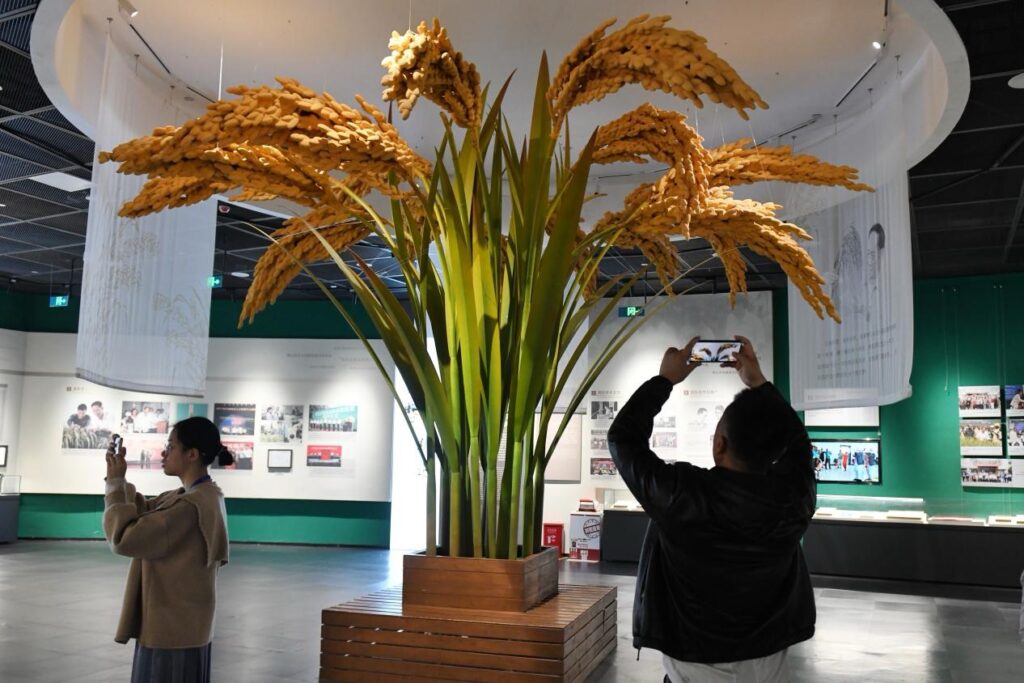On October 28, 16 senior representatives from overseas Chinese media outlets participating in the “Opportunity China – 2024 Overseas Chinese Media Leaders’ Visit to Changsha” event visited the Hunan Hybrid Rice Research Center and the Longping Rice Museum. The visit allowed them to explore the history of China’s advancements in hybrid rice and witness the transformative power of a single grain.
Hunan is the birthplace of hybrid rice. The Hunan Hybrid Rice Research Center, located in Changsha’s Mapoling area, along with the National Hybrid Rice Engineering Technology Research Center established based on it, is the world’s first dedicated research institution focused on hybrid rice. The center’s founder, academician Yuan Longping, known as the “Father of Hybrid Rice,” pioneered this research. The center emphasizes breeding high-yield, high-quality, multi-resistant hybrid rice varieties and researches complementary technologies for hybrid rice, as well as demonstration and promotion.
In the 1950s and early 1960s, classical genetics asserted that rice, being self-pollinating, lacked hybrid vigor, and countries like the United States and Japan considered hybrid seed production an unsolvable issue, abandoning research on it. In 1973, Yuan Longping announced the successful development of a three-line system for indica hybrid rice, marking a significant breakthrough in harnessing the hybrid advantages of rice in China.
Over the past decade, Yuan Longping and his team made substantial advancements in super-hybrid rice, achieving successive yield milestones: 700 kilograms per mu in 2000, 800 kilograms in 2004, 900 kilograms in 2012, and 1,000 kilograms in 2014. On October 18, 2021, the record for double-crop hybrid rice reached 1,603.9 kilograms per mu.
According to Huang Dahui, an international trainer in hybrid rice technology at the Hunan Hybrid Rice Research Center, “Yuan Longping was an ordinary young teacher at the time, yet he boldly challenged classical genetics.” Today, hybrid rice has been promoted on more than 10 billion mu (667 million hectares) in China, resulting in an increase of 100 million tons of rice and making a significant contribution to China’s food security.
Internationally, the UN Food and Agriculture Organization recognized hybrid rice as a priority technology for addressing food shortages in developing countries as early as the 1990s. Since 1979, when hybrid rice first ventured abroad, it has been tested and promoted in over 70 countries, with commercial applications in 10 countries, covering an annual area exceeding 1.2 billion mu (80 million hectares).
Changsha-based Yuan’s Seed Industry High-Tech Co., Ltd., collaborates on hybrid rice projects worldwide. In Africa, it has created a full industrial chain centered in Madagascar, extending to countries such as Nigeria, Angola, Guinea, and Kenya, thereby localizing Chinese agricultural technology and varieties for African development. Li Yanping, Deputy General Manager of Yuan’s Seed Industry International Department, said, “Since 2008, our trials in Africa have reached 80,000 hectares, with average yields surpassing 7.5 tons per hectare.” The company works with local farmers through partnerships to encourage hybrid rice cultivation.
Longping High-Tech, also based in Changsha, has been engaged in international hybrid rice technology training since its founding in 1999, promoting the localization of agricultural talent. Liu Famo, Vice President of the Longping High-Tech International Training Institute, stated that the company has trained 10,000 agricultural officials and technicians from over 100 countries across Asia, Africa, Latin America, and the South Pacific, contributing to food security worldwide.
“Global hybrid rice coverage” was Yuan Longping’s lifelong dream, and Hunan’s researchers are fulfilling his legacy. From an aerial view, the Longping Rice Museum on the east bank of the Liuyang River resembles a golden rice ear in autumn. The museum, the first large-scale rice museum in China, spans 6,000 square meters and houses over 8,000 artifacts, narrating China’s ancient rice cultivation culture and the story of Yuan Longping.
Pan Min, director of the Longping Rice Museum, expressed that Yuan Longping’s scientific spirit and dedication are invaluable assets to modern agricultural science. The museum hopes to be a platform where more people can appreciate Yuan Longping’s relentless pursuit and the profound agricultural heritage of the Chinese civilization.

